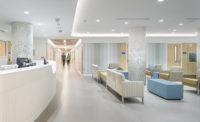Built with natural materials and a no-frills design, the new St. Charles Bend Cancer Center in central Oregon reflects the earthy flavor of this pioneer town, where adventure and outdoor sports such as rock climbing, mountain biking, and skiing are a way of life.
Designed by Portland, Oregon–based ZGF Architects, the 16,000-square-foot two-story building is the latest addition to the St. Charles Medical Center, a series of wings off a large original structure, designed by SOM, that dates back to 1974.
St. Charles is the only comprehensive cancer center in the region, and patients travel up to 300 miles to receive treatment in Bend, where they might stay for up to six weeks. The new wing brings the medical oncology and radiation oncology treatment teams and services under the same roof for the first time. (Previously, medical oncology was located at a satellite campus a mile down the road, a logistical nightmare for patients who had to shuttle back and forth for their chemotherapy and radiation treatments.)
Oriented toward the southwest, the steel-frame orthogonal structure is perfectly positioned to capitalize on breathtaking views of Pilot Butte to the south and the snow-capped Cascades to the west. To blend in with the surrounding landscape, the architects clad the building with a sustainable and durable skin made of wood-like hybrid panels comprised of rice husks and mineral oil, and lightweight cement fiberboard in subtle shades of gray.
The warm natural materials continue inside, where light pours into a glazed double-height lobby with wood-paneled walls adorned by works of local artists, including a painted-tile triptych depicting Pilot Butte and the Cascades by Kathy Deggendorfer spanning the back wall. “We tried to continue that indoor-to-outdoor connectivity, with pieces that are uplifting and reflect the local scenery,” says ZGF interior designer Paul Evans.
The architects organized the first-floor examination area in layers to maximize patient comfort. An inner core, housing an open-plan staff work area, is surrounded by patient exam rooms lined by corridors with floor-to-ceiling windows on the perimeter. The actual examination rooms are enclosed by frosted-glass sliding doors with a “rice paper–like quality” that provide both privacy and indirect daylight. If patients or their family members need to take a breather, they can stroll outside around the healing garden and walk across a reflecting pool on “floating” pavers or sit on a bench and watch nesting ducks. There's also a lawn for yoga, Tai Chi, and other restorative activities. (Those services also are offered indoors in new integrative-therapy rooms, where patients can have massages, acupuncture, or Reiki.)
On the second floor, the infusion clinic—a spacious open-plan room with high ceilings and arresting views of the mountains—feels more like a spa than a hospital. Patients can sit for their infusions in groups of three or four, in a private room, or bays screened by resin sliding doors that incorporate dried grasses. “It's so open—it's not clinical—and that's what makes it comfortable,” says ZGF partner Karl Sonnenberg. If they're feeling up to it, patients can sit on a deck that overlooks the healing garden and get their treatment outdoors. “There's always a connection to nature,” says ZGF partner Gene Sandoval.
During the design process, the architects built, at a nearby dude ranch owned by the project's general contractor, full-scale mock-ups of the lobby and infusion center. Doctors, nurses, and patients reviewed and critiqued the mock-ups, with the architects making changes on the fly. “When we were talking to patients, one of the things that was really important was having options—opportunities to have conversations and interactions with their families and more of a group dynamic—and alternatives for privacy if they were feeling more withdrawn or sick,” says Evans.
The result is both functional and striking. “We didn't want to make a big statement—we wanted to complement the other buildings and be sensitive to the campus,” says Sandoval. For the patients, it provides a sense of well-being.
PeopleFormal name of building: Location: Completion Date: Gross square footage: Total project cost: Total construction cost: Client: Owner: Architect: Personnel in architect's firm who should receive special credit: Architect of record: Interior designer: Engineers: Civil: Hickman, Williams & Associates Mechanical: PAE Consulting Engineers Electrical: Sparling Consultant(s): Lighting: Sparling Acoustical: SSA Acoustics Other: Lean Design: Lean Healthcare West with ZGF Architects LLP General contractor: Size: 16,000 square feet (addition), 8,000 square feet (renovation) Construction cost: $10 million Completion date: August 2014 |
ProductsStructural system Exterior cladding Curtain Wall: Oldcastle BuildingEnvelope, Guardian, Kawneer Rainscreen: Okoskin, Resysta Moisture barrier: Henry Roofing Windows Glazing Other: Exterior Sun Shades: Construction Specialties Doors Metal doors: Steelcraft Wood doors: Marshfield Door Systems Sliding doors: Kawneer, Hafele Special doors: Folding Glass Partitions: Modernfold Hardware Closers: LCN, Rixon Exit devices: Von Duprin Pulls: Trimco Security devices: Schlage Interior finishes Wood Ceilings: USG Suspension grid: USG Cabinetwork and custom woodwork: McCarthy Manufacturing Inc. Paints and stains: PPG Paneling: USG TrueWood Plastic laminate: Wilsonart Solid surfacing: Corian, Avonite Special surfacing: Resin Panels: 3 Form Floor and wall tile: Floor: Pental; Wall: DalTile Resilient flooring: Nora, Teknofloor, Mannington Carpet: Lees Furnishings Reception furniture: Lobby: Arcadia (chairs), Cumberland (tables) Chairs: Herman Miller, SitOnIt Seating Tables: Cumberland, Herman Miller, West Coast Industries Upholstery: Architex, Momentum, ArcCom, Mayer, Maharam Other furniture: Champion (recliner/treatment chair) Lighting Downlights: Philips Task lighting: Eureka Exterior: Bega, Hydrel, RAB Dimming System or other lighting controls: Lutron, Greengate Conveyance Plumbing |














